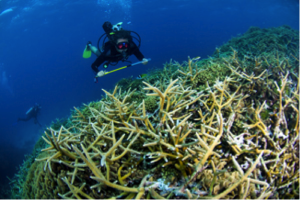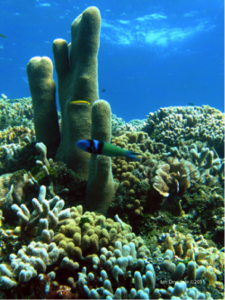Supporting and Managing Resilient Systems in the Bay Islands, Honduras
Location
Cordelia Banks, Roatán, Bay Islands, Honduras
The challenge
Cordelia Banks is located on the southwest coast of Roatán in the Honduran Bay Islands. It sits between two cruise docks, as well as the two largest towns in the Islands, Coxen Hole and French Harbour. Cordelia Banks is made up of three large coralline banks covered extensively by staghorn coral (Acropora cervicornis) colonies. The abundance of this species has been reduced by 98% within the Caribbean, becoming critically endangered as defined by CITES. Smith Bank, the most studied of the three banks, has an approximate area of 52 acres, and could possibly be the largest patch of A. cervicornis within the Mesoamerican Reef. It is an important source of coral spawn, critical because it can help repopulate reefs of the Caribbean where Staghorn has already disappeared. The area has been identified as a spawning aggregation site for groupers and snappers and hosts a healthy community of Caribbean gray reef sharks (Carcharhinus perezii).
An Atlantic and Gulf Rapid Reef Assessment (AGRRA) has been carried out (almost) every two years since 2006. The findings have shown that Cordelia Banks boasts a staggering 60% live coral cover (in certain study sites). This is the largest coral cover ever recorded by this methodology in over 800 sites Mesoamerican wide. The methodology was reviewed and adjusted by the authors in order to effectively measure and quantify the coral colonies as dense as those found in Cordelia Bank. Cordelia’s biological importance, as well as the threats it faces, makes its complete protection an urgent matter. The effects of coastal development have increased due to the natural attractions of Roatán and the increase in tourism-related investment. Several populated towns also have an indirect influence over Cordelia Banks. It is also located within maritime transport and cruise ship routes, which could easily increase pressure on this fragile ecosystem.
Actions taken
In 2009, WWF worked with the Roatán Marine Park (RMP) and Luna Environmental Consulting to develop a technical paper describing the ecological significance of the area proposed for protection, which provided the foundation for the next phase of work funded by the Ocean Fund. This document included a Technical Data Sheet about the importance of Cordelia Banks, Rationale for the Request to Declare Cordelia Banks a Site of Wildlife Importance, and the management objectives to promote it as a marine protected area (MPA).
The government issued the official declaration for the Honduran Bay Islands National Marine Park (BINMP) in June 2010. This declaration created a marine park encompassing the coasts and marine waters surrounding all three of the Bay Islands (Roatán, Utila, and Guanaja). The Bay Islands National Marine Park area covers 6,471.5 km2.
Cordelia was declared as a Site of Wildlife Importance by the Protected Areas Department within the Forestry Conservation Institute in May 2012, and it covers an area of 17 km2. The management plan was developed to fit within the framework of the Bay Islands National Marine Park, and was approved in September 2013. Since the declaration, monitoring has found that Cordelia boasts the largest patch of staghorn coral (Acropora cervicornis), and highest live coral cover for cervicornis in the Mesoamerican Reef. The area remains a productive fish spawning and reproductive aggregation site. As of 2022, researchers are awaiting final results to determine if the Cordelia site is reseeding cervicornis to the reefs in the Bay Islands and the North Coast, and possibly even Belize and Guatemala.
Four main strategies are underway to build effective conservation for the Park:
- Support organizing and strengthening departmental, municipal and local advisory councils, specifically those concerning Cordelia Banks, utilizing partnerships with community advisory councils.
- Raise public awareness of the Forestry Law, Protected Areas Act, General Regulations and Special Law of the Bay Islands among Cordelia Banks stakeholders, utilizing partnerships with community advisory councils.
- Share the regulations contained in the management plan, with local stakeholders, in order to reduce illegal activities and foster community involvement in management.
- Collaborate with local partners such as BICA Roatán to monitor marine water quality in 37 sites in the Bay Islands National Marine Park; this includes sites in proximity to Cordelia Banks. This information supports local efforts to promote clean water for reefs and investment in sanitation infrastructure and management.
Community Advisory Councils and Technical Committees
The community advisory councils are a community-based participation, consultation and support platform to the Protected Areas Department within the Forestry Conservation Institute (ICF) and municipalities to manage the natural resources, protected areas (PAs), forest areas and wildlife as stated in the Forestry Law. The councils were key participants in the design and support of the development of the Management Plan for the Bay Islands National Marine Park. Each Community Advisory Council includes representatives of the organizations such as: Patronatos (community councils), water boards, community tourism groups, school boards, fishers organizations or representatives, and other social and productive organizations in the communities that border and/or are within the protected areas.
These councils were created to support all protected areas in the country. PAs and MPAs in Honduras are created by the central government, but the entities in charge of managing them are NGOs, who sign a co-management agreement with ICF (and should have municipal support). ICF is the president of the Technical Committee for the Bay Islands National Marine Park, which includes a total of 14 co-managers and 2 support organizations (Coral Reef Alliance and Healthy Reefs Initiative). Relations with the local municipal governments now exist due to their responsibilities as co-managers. The primary local government organizations involved are the environmental unit, tourism office, and the mayor or vice mayor. Unfortunately, there is limited to no funding from the Central Government to manage these areas, and NGOs must turn to imaginative ways of raising operative funds.
Training was conducted, along with capacity building for the Community Advisory Councils on aspects related to the socialization of the Protected Areas Law in the preparation of the Management Plan for Bay Islands National Marine Park. A trip was held for government representatives (Minister and Congress) to Cordelia Banks to celebrate the declaration of the site as one of Wildlife Importance. Cordelia Banks is also managed as a Marine Sanctuary for Sharks (Honduras and Palau Islands are the only two countries in the world where it is illegal to fish sharks and sell any of their by-products). Finally, Community Marine Reserves or no-take zones have been established in coordination with the fishermen’s associations and the Community Advisory Councils. The no-take zone has been established within Cordelia Banks in the zoning chapter of the Management Plan. The no-take zone is being reviewed as part of the ongoing (as of 2022) update of the BINMP management plan.
How successful has it been?
The Coral Reef Alliance (CORAL) and the Roatán Marine Park (RMP) received a grant in 2012 to acquire a patrol boat for the area which has been patrolling the area alongside other vessels that patrol other key areas. Roatán Marine Park, with a park Ranger and a National Policeman onboard, coordinates patrolling activities.
CORAL funded a fisheries survey/assessment, carried out by Centro de Estudios Marinos’ Steve Canty. This information was very helpful in the creation of the management plan, as it allowed identifying key players within the fishing community. These stakeholders were invited to help create the no-take zone, during the meetings to write up the management plan. TNC, with USAID funding, organized these fishermen into a legal organization.
Zoning was completed with the instillation of buoys through a joint effort carried out by CORAL, RMP and Healthy Reefs Initiative (HRI), with support from the Port of Roatán which also donated an engine for the boat. However, due to challenging weather conditions, the buoys required extra maintenance which was unable to be completed due to the need for additional investment to ensure safe, and long-term installation.
The biological monitoring of the area is being done in several ways. Reef health is defined using the AGRRA protocol and HRI’s Simplified Integrated Reef Health Index (SIRHI), alongside many other local organizations. Coral spawning and a grouper/snapper spawning/aggregation site are also monitored on the right phases of the moon. CORAL is currently collaborating with RMP to monitor two fish spawning aggregation sites in Roatan and will be adding a third site.
Lessons learned and recommendations
- Consolidating the advisory councils was a necessary step prior to designing the management plans, as these are usually the users of the resources in these protected areas.
- With the Ocean Fund Grant, WWF was able to engage the local communities to move forward, after the legal declaration of the Bay Islands National Marine Park. Without WWF’s involvement, as well as ICF, Honduras Directorate General of Fisheries and Aquaculture, and CORAL, the Cordelia Banks advisory council would not have become active. Without an active advisory council, the role of the Bay Islands National Marine Parks’ Technical Committee would have been significantly more difficult due to having to begin stakeholder engagement and advocate to secure a protection status for Cordelia Banks.
- The Ocean Fund was catalytic to assuring the long-term legal status and conservation of Cordelia Banks by setting the stage for successfully designing the management plan.
- Involving the local fishermen in the creation of the management plan was a key element in defining the no-take zone, as well as identifying the sites to install fishing moorings.
- AGRRA and HRI’s SIHRI was a valuable tool that helped identify the biological importance of the site, based on the outstanding coral cover found.
- CORAL has been leading the discussion about the development of a Bay Islands Conservation Trust Fund. Working with government officials, CORAL has facilitated several meetings to determine the use of mitigation funds that otherwise would not be accessible for the ongoing management of marine protected areas in the Bay Islands (mitigation monies would simply roll over into a general fund). This new conservation fund would shore up long-term sustainable financing for Cordelia Banks and the Bay Islands (a minimum of $75,000 per year for 30 years is identified as mitigation for maintenance activities of a cruise ship dock).
- The Ministry of Tourism provided initial funding for the creation of the first BINMP management plan, which was later updated with funding from MARFund and CORAL later provided complementary funds to finalize the second update. A third version of the management plan is now being funded by the ICF with support from KfW Development Bank.
Funding summary
World Wildlife Fund
Oak Foundation
Summit Foundation
Coral Reef Alliance
The Nature Conservancy
Ocean Fund
MAR Fund
Roatán Marine Park
The Pew Charitable Trusts
Port of Roatán
Lead organizations
Healthy Reefs Initiative
Coral Reef Alliance
Partners
Healthy Reefs Initiative
WWF-Mesoamerican Reef
Roatán Marine Park
Coral Reef Alliance
The Nature Conservancy
Port of Roatán
Resources
Video: Cordelia Banks – Jewel of the Meso-American Reef
Video: Treasures of Roatan: Cordelia Bank
WWF Report: Coral Reef Protection in Cordelia Banks
Cordelia Banks Technical Paper in Spanish







